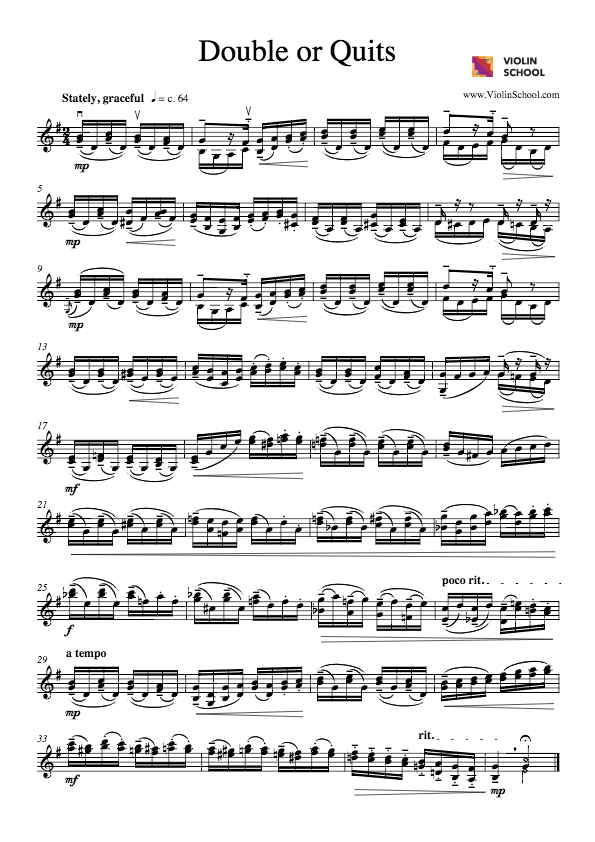We've received a lot of good feedback about the G Major and D Major scale exercises (Level 1/2), so we've now added similar exercises for A Major as well!
You can find them in the ViolinSchool Library in the Scales and Arpeggios section.
free access, login required
free access, login required
membership login required
membership login required
membership login required
Enjoy!
Everything you need to know to get the strings of your violin to the correct pitch... and keep them there!
In this feature, you'll learn...
First we're going to learn about the pitch frequencies of each string, so we know what to aim for when tuning the violin!
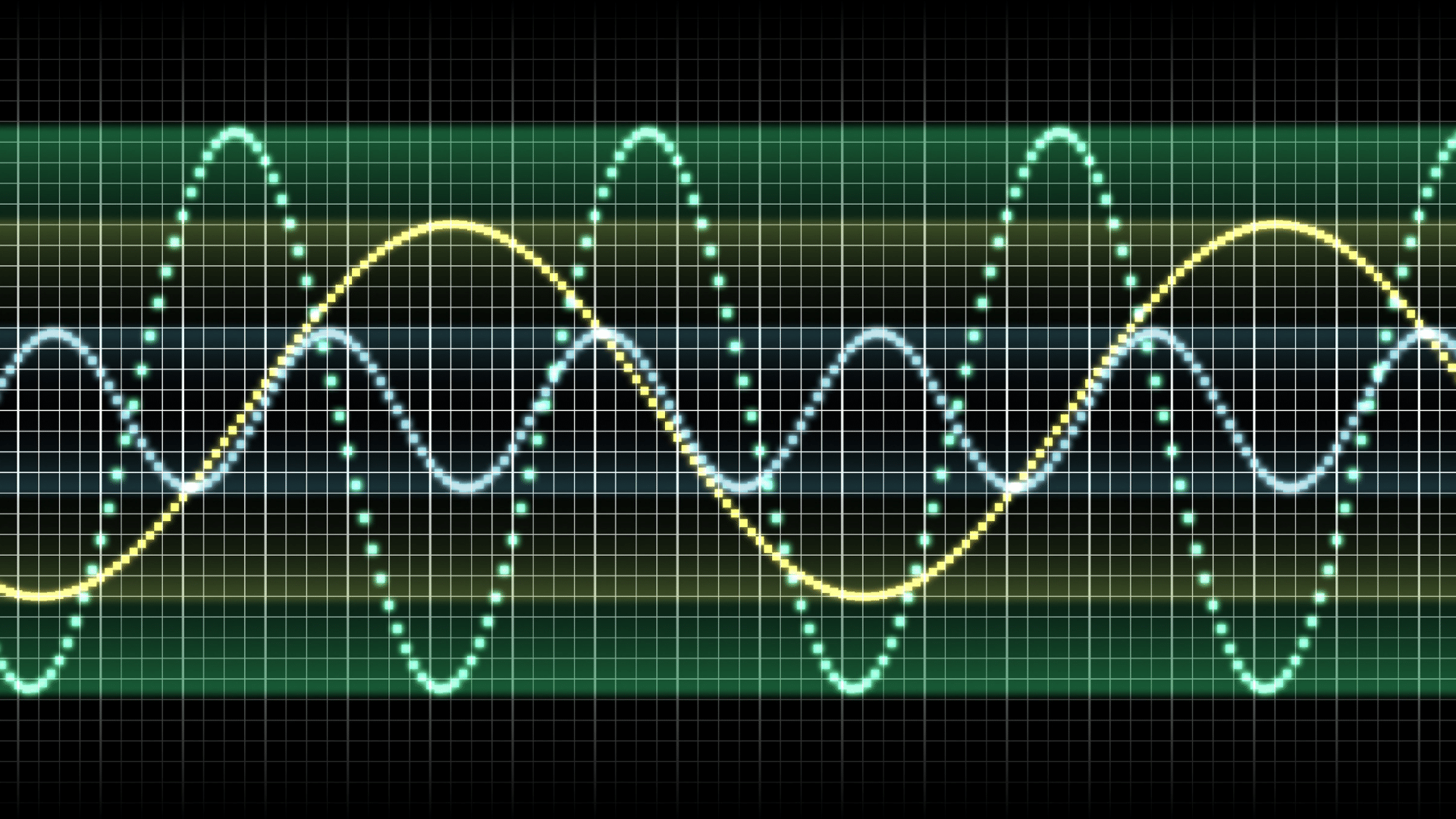
The strings of the violin are tuned to the notes G, D, A and E.
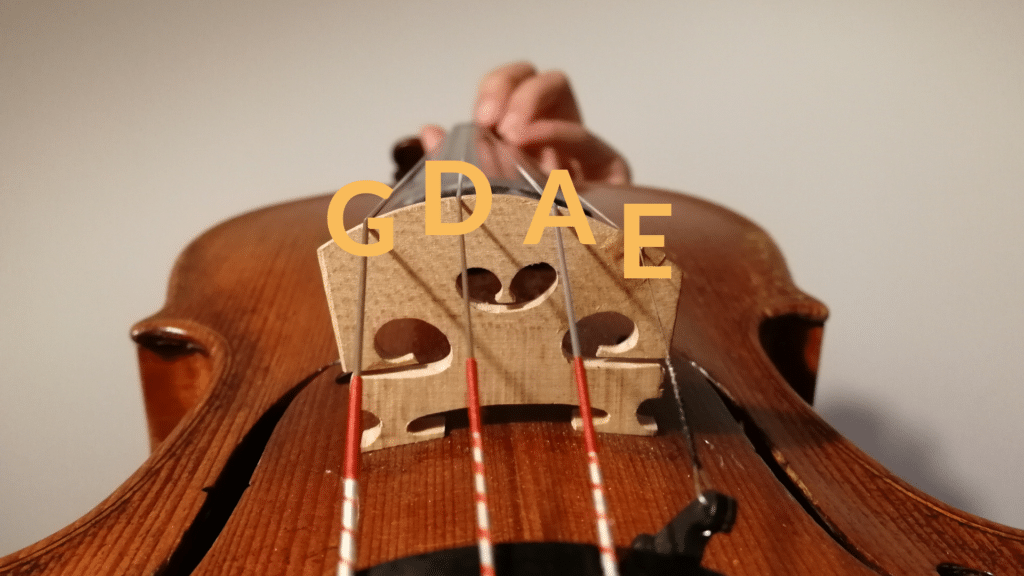
Each of these 'note names' describes a frequency of sound. The exact frequency can vary a bit depending on what style of music you're playing, or where you are in the world!
But the most commonly accepted tuning for the note A is 440Hz (Hertz). This is the sound produced by 440 sine waves per second. It sounds like this:
This frequency was decided on by the International Standards Organisation in the 1970s. Since then, the tuning of each string has been measured on the assumption that the frequency of A is 'fixed' at 440 sine waves per second.
Although there's a big debate amongst some musicians about whether this is correct (at our London School for example, we generally use A = 441Hz), we're going to assume that you just want to get your violin in tune as fast as possible... so we're going to stick with the A = 440Hz standard for now!
From A, we can work out the frequency of all the other strings. Each violin string is different to the next by an interval of a perfect fifth. This basically means that each string is five notes of the scale away from the next one.
SIDE NOTE: Tuning is actually a bit more complicated than that... a 'perfect fifth' actually describes two notes which have a ratio of 3:2 between their frequencies... if you want to know more about this, look up 'perfect fifth' and 'A440' on Wikipedia, or consult the ViolinSchool Glossary!
So, here are the other strings:
The G string is tuned to the frequency of 196 Hertz:
The D string is tuned to the frequency of 293 Hertz:
The A string, as we've already discussed, is tuned to 440Hz:
And the E string is tuned to 659Hz:
Before we get into the physical 'how-to' of tuning the violin, let's get clear on what we actually want to achieve.
To tune a violin accurately, you need to be sure that you're aiming for the correct right pitch in the first place. So it's a good idea to have a sound that you can 'refer' to. Let's call this a 'reference pitch'.
Your reference pitch will usually be A. This is because the 'international standard' has led to musicians all over the world tuning the A first, to be sure that it fits the fixed standard of 440Hz.
This is why you will usually hear a symphony orchestra tuning to an 'A' played by the lead oboe player. It's also why violinists will often start by tuning the A string, before they tune the other strings of the violin.
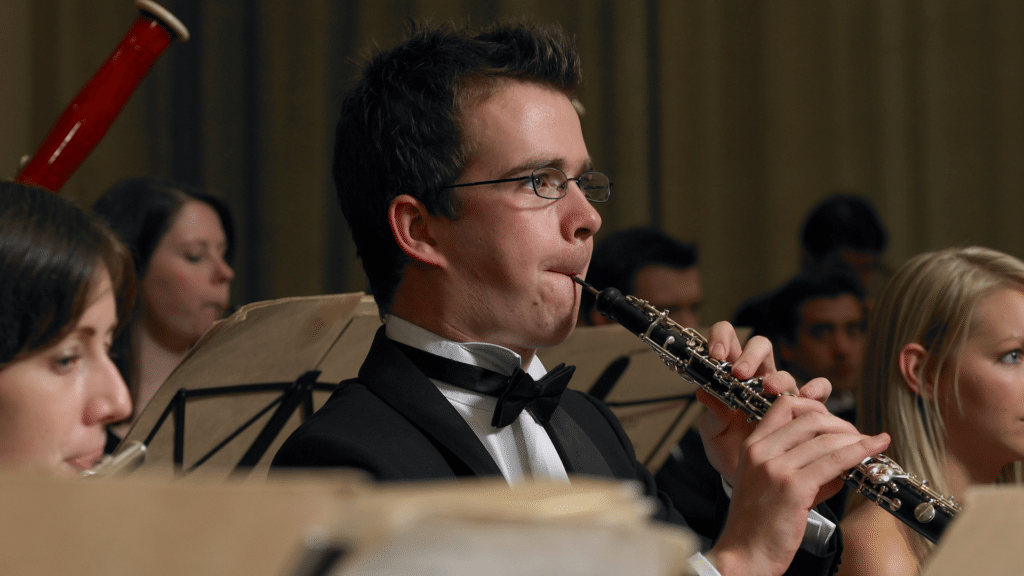
Thanks to modern technology, it's now easier than ever to find an accurate sound source to give you an 'A' you can tune to:
Piano or Keyboard
If you're fortunate enough to have access to a keyboard or a piano, then you can play the 'A' and tune to that. Listen carefully to the sound before you play it on the violin.
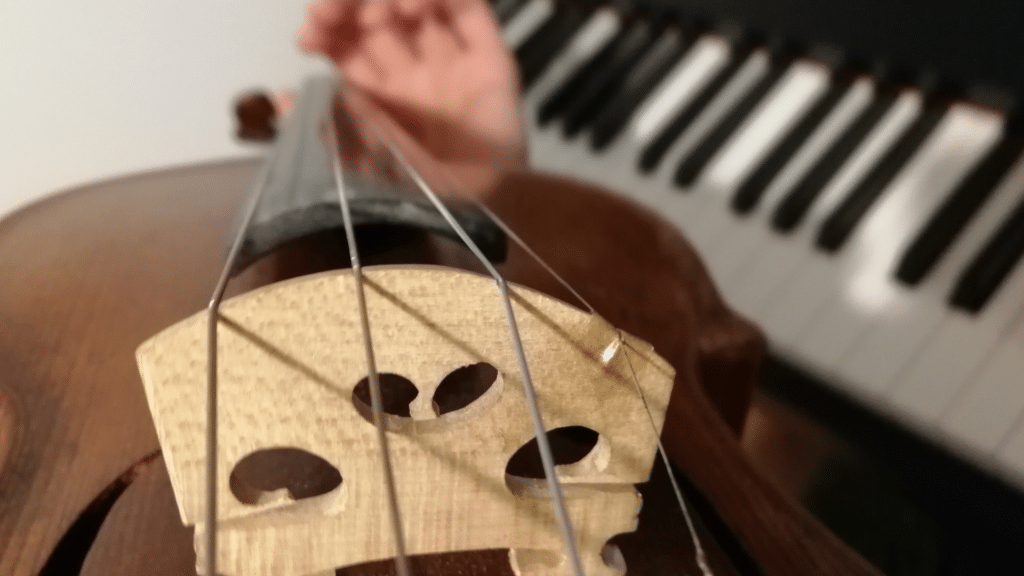
Digital Pitch App
A smartphone app is a great way of getting a clear 'reference pitch'. You can set the pitch you want, listen to it, and get feedback from the app about whether or not you've hit the right note. Just don't become dependent on it!
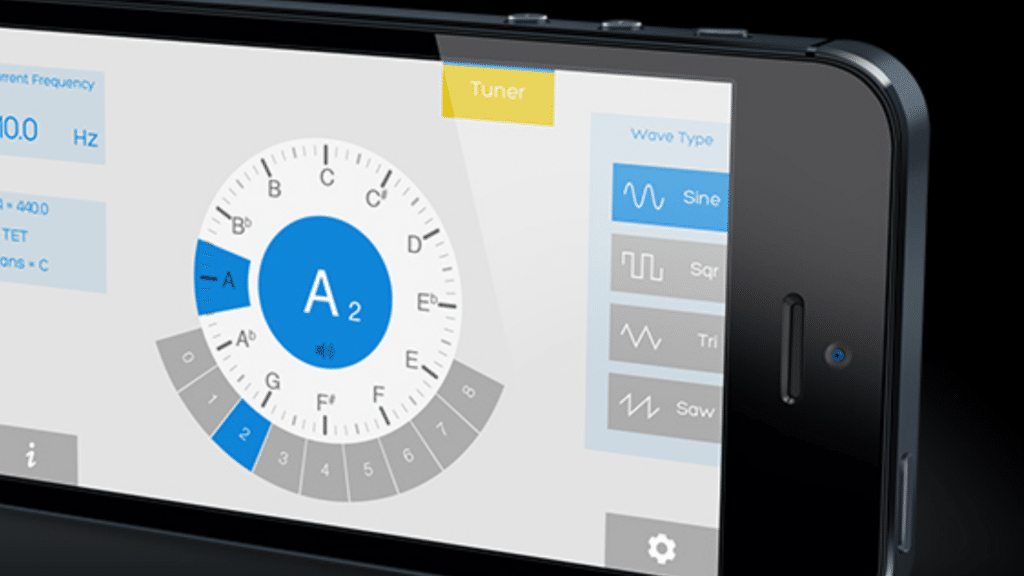
Online Tone Generator
If you don't have access to a smartphone, then you can use an online tone generator - like the ones at the top of this page - instead.
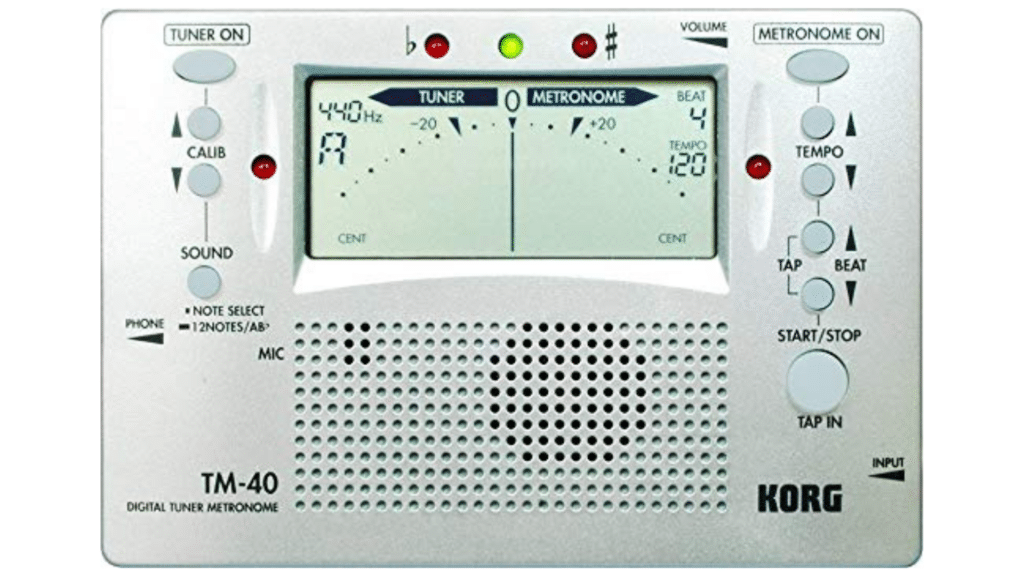
Offline Tone Generator (e.g. on a Metronome or Tuner)
Digital tuners pre-date smartphone apps, and are widely available from music retail stores. Be sure to check the accuracy level of the display, as some tuners measure pitch in more detail than others!
Some metronomes also have a pitch function built in, which allows them to generate the sound of an 'A'. But unlike an app, where you'll often be able to change the pitch of A, a piece of hardware like a metronome with an extra tuning function can often be fixed at 440Hz.
Tuning Fork
A tuning fork is a two-pronged piece of metal (usually steel) that resonates to produce a pre-determined pitch (most commonly A 440Hz) when you hit it against something!
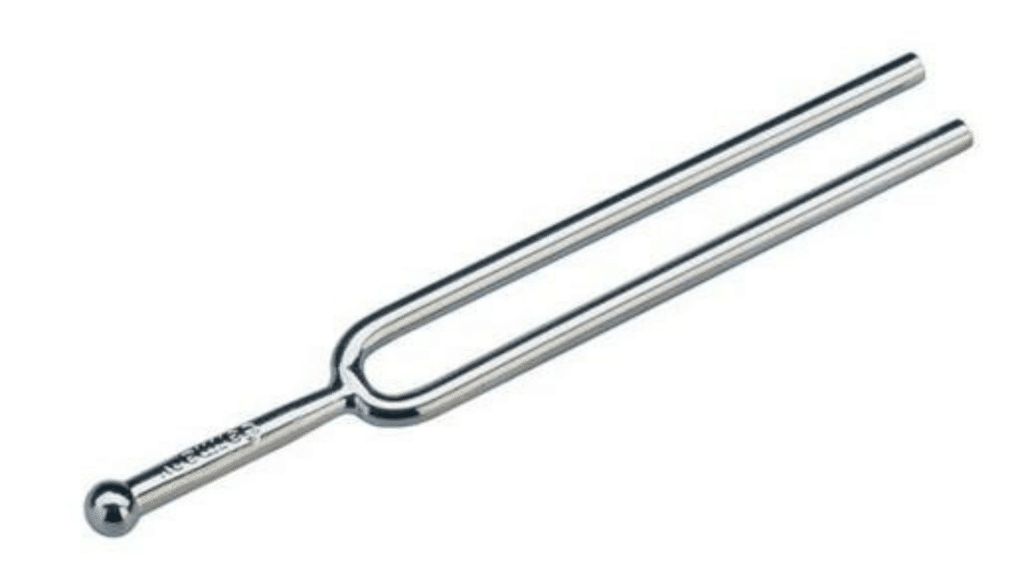
Pitch Pipes
Pitch pipes are small tubes that you can blow in order to produce a sound. Each pipes will be fixed to a pre-determined frequency, so they will always produce the same note.
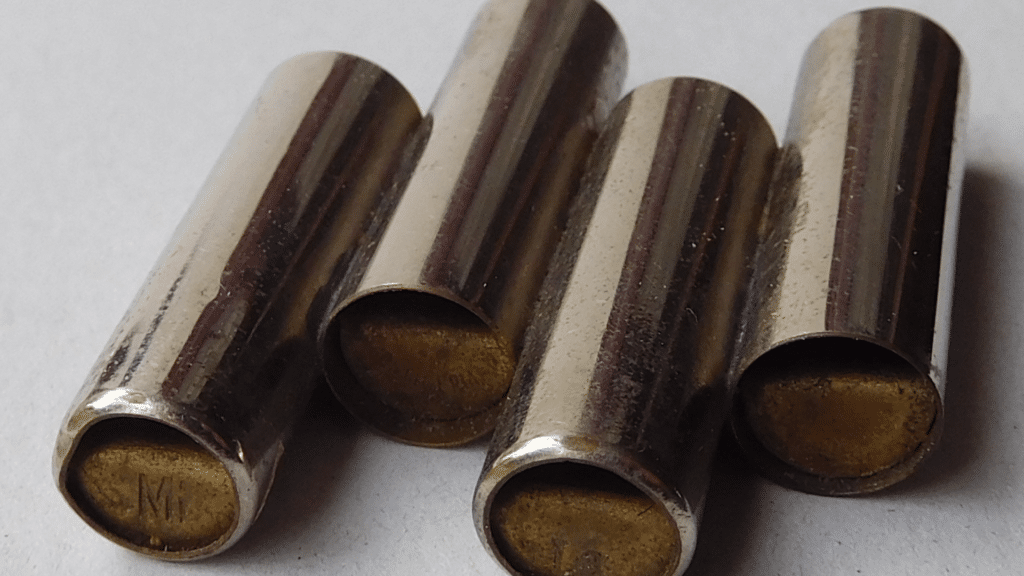
SIDE NOTE: When tuning the violin, it's really important that you allow the string to vibrate clearly, otherwise you might not hear the pitch accurately. So try not to 'pick' at the strings with the bow… instead, play long, resonant strokes and use the whole bow.
Once you have plenty of experience, it is possible to tune a violin by plucking the strings. But it's still easier to hear the pitch if you play the strings using the bow!
If you’re a beginner or if you don’t have much experience with music, your listening might not be ‘attuned’ to the subtle differences in pitch. This will happen over time.
But whilst your pitch awareness is developing, it’s a good idea to use a visual reference as well as an aural reference. This will give you confidence and certainty about being 'in tune'.
Nowadays, a visual reference can usually take the form of a pitch app such as InsTuner on iOS, or Cleartune on Android. Beware of tuners and apps that aren’t very accurate though, and don’t just follow the traffic light system - look at the dial to see how far you are away from your target pitch.
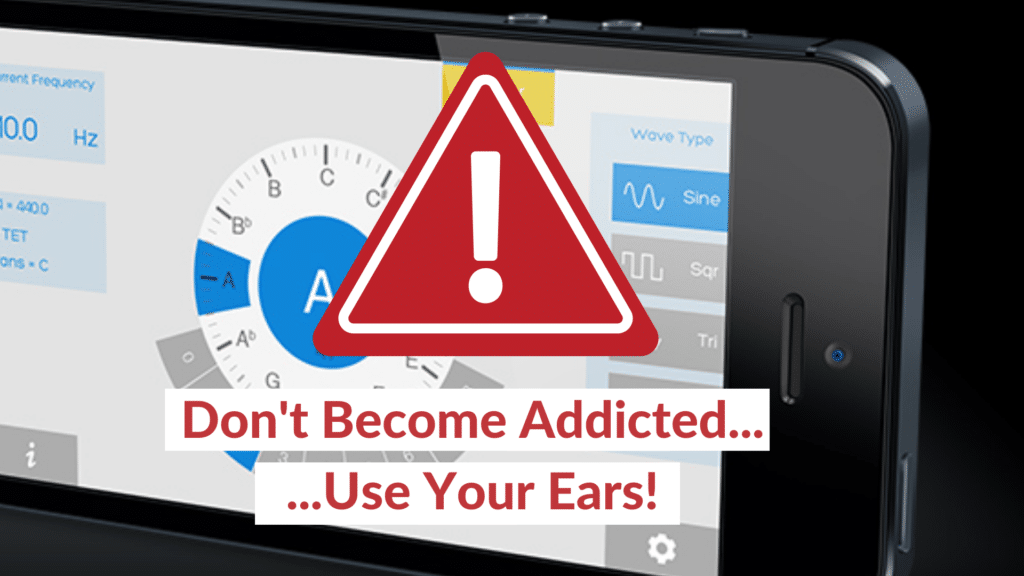
A useful approach is to use pitch apps to check the pitch only once you have already made the adjustments by ear! Then you're training your ear by making the aural adjustment first... and the visual reference serves as a confirmation (or not!) of what you've already done.
Over time, the more experienced you become at tuning using aural references, the less you'll need to refer to the visuals. Eventually you may not need to refer to a tuner at all!
We change the tension - and therefore the pitch - of the strings, by turning either the Pegs or the Fine Tuners.
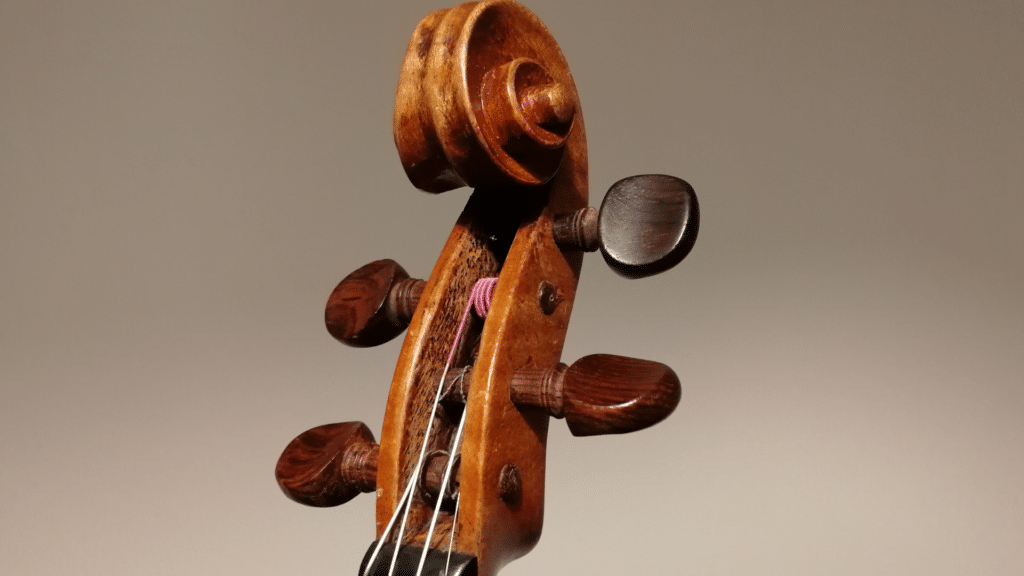
The pegs are the four wooden pins that sit in the pegbox of the violin, just underneath the scroll. Each peg has a small hole in the side of it, just big enough for the string to thread through.
This allows the string to be secured inside the peg, so that it can be wound and unwound safely and securely.

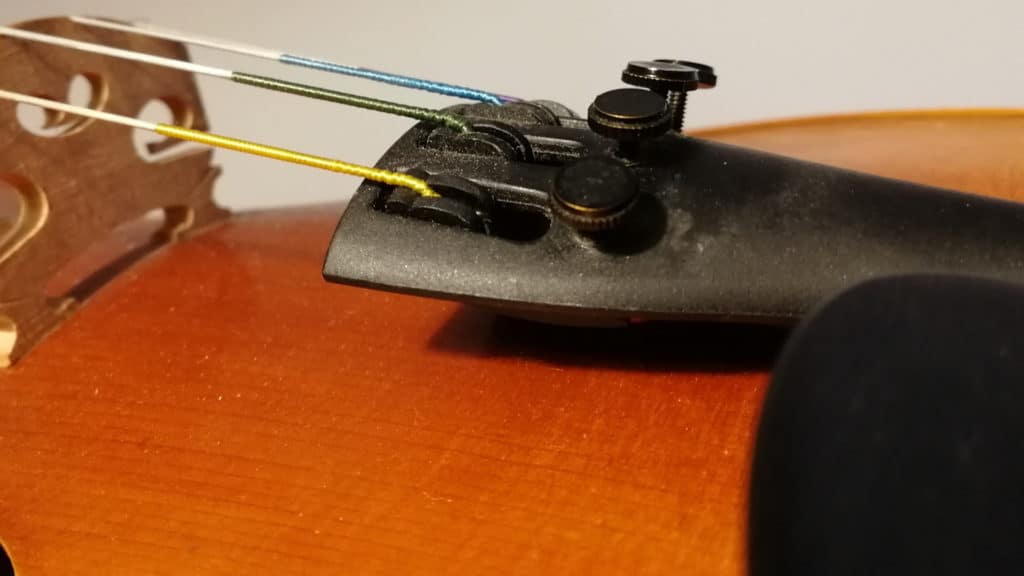
The fine tuners are four small metal screws which are mounted near the top of the tailpiece of the instrument. They work by bringing the metal attachments closer together when screwed.
The bottom end of each string is pulled further towards the violinist (and away from the pegs). This:
As a general rule:
If your violin is very out of tune, or if you've just changed a string and need to make a big adjustment to the string tension, then start by using the pegs.
WARNING! Whatever you do, don’t turn the pegs too quickly or too far ... otherwise the string might snap!
Also, do NOT try and turn the peg away from you without first releasing it towards you!
Although it can sometimes work to turn the peg away from you straight away, this should only be done if:
a) you're very experienced, and
b) you've already tuned the violin you're working with by turning the pegs (so that you can feel how the string responds)
The first time you pick up a violin you should quite simply NEVER turn the peg away from you without releasing it towards you first.
Otherwise you are very likely to overturn the peg, creating too much tension. If you do this, it will snap!
Turning the Pegs
Pegs can often be tough to turn, especially if the violin you're using hasn't been used for a while (or hasn't been 'set up' by a specialist violin shop). This is because of the friction between the peg and the peg box.
STEP 1: RELEASE PEG TOWARDS YOU (Release the String Tension)
Get into playing position, and be ready to play (you'll need to bow the string to hear the changes in pitch).
Hold the scroll or pegbox of the violin with your left hand, to provide support and leverage, and then extend your fingers/thumb towards the peg you'd like to turn.
Gently turn the peg towards you. Be careful in case it is extra-slippery or extra-hard. Use the other fingers and the hand to stabilise your movements.
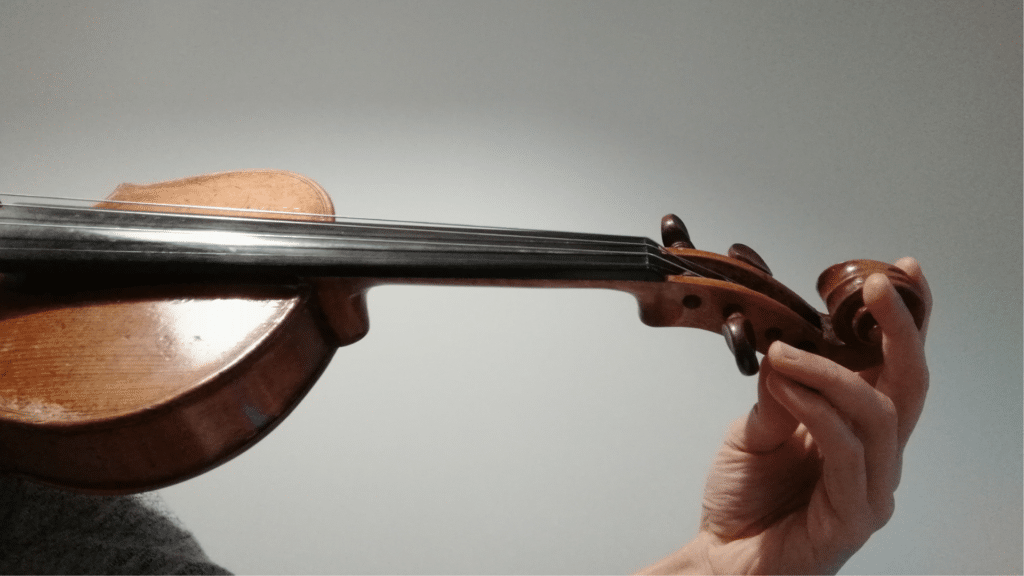
Keep playing the string whilst you turn, so that you can hear the sound of the pitch changing.
Don't turn too far! Only turn enough that the pitch of the string is a note or two lower than the target pitch. Then it's time to wind it up again..
STEP 2: WIND PEG AWAY FROM YOU (Increase the String Tension)
Adjust your hand position so that you are ready to 'lever' the peg back to the right position. This usually requires your thumb to be underneath the peg, so that you are applying force to the underside of the peg.
Awkward-to-turn Pegs
If the peg has got into a near-vertical position, this can be very tricky... if you find you can't do it because you can't apply enough force at that angle, then try sitting down, placing the violin upright on your leg, holding the scroll in one hand, and turning the peg with the other.
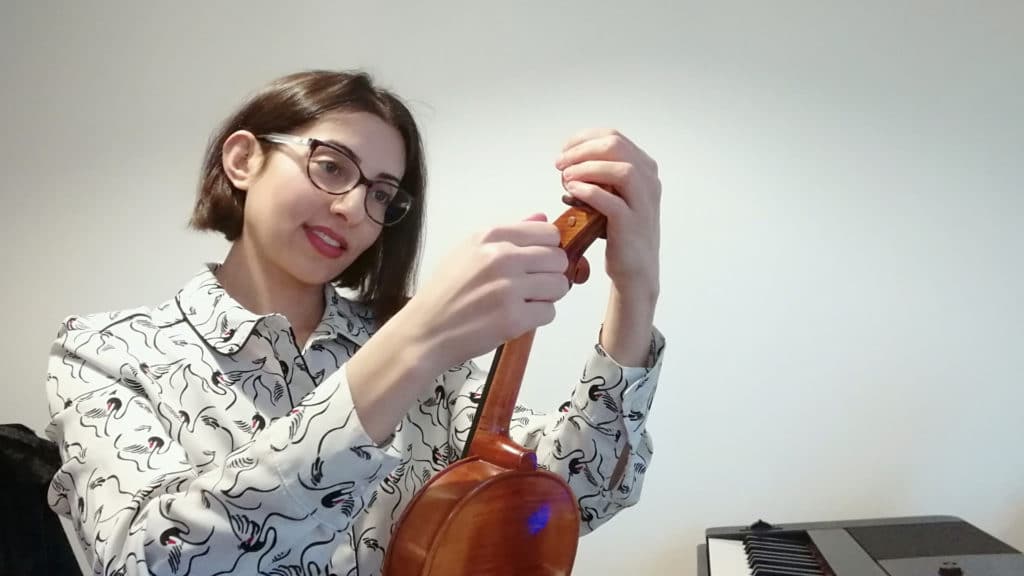
Using pegs when the strings are very 'out of tune'
If all four strings of the violin are quite far from their correct pitches, then don’t try and get each string perfect the first time you turn the pegs. This is because if you turn the peg for one string quite a long way, then it will affect the intonation of the other strings.
Instead, go around all the strings couple of times, using the pegs to get each string to approximately the right pitch. By the time you’ve done this twice, or even three times, your movements will be smaller, and tuning one string will no longer affect the other strings.
Tuning only with pegs…
If you do not have fine tuners on your violin, then you will need to achieve an extremely high level of accuracy when tuning with the pegs.
But this can rarely be achieved by making smaller movements, unless the pegs are extremely smooth (or you have geared pegs, a relatively new invention that makes tuning with the pegs very easy!).
Therefore, you may find yourself needing to release and re-wind the tension of a string several times, making the string flatter, and then bringing it up again sharper.
Essentially you are synchronising your listening with the subtleties of the pegs and strings of the violin that you're currently tuning.
By listening to the change in the pitch the first few times you use a peg to change a string's tension, you are 'acclimatising' your ear so that you know how that peg and string behaves.
This is why you will sometimes hear a violinist releasing the peg and then tightening it several times. Essentially they are getting used to how the peg / string behaves on that violin right then and there.
Once you're used to this, you can adjust the speed and distance of your tuning movement to increase the accuracy of your 'big' peg-winding movements. Then you can land on precisely the note you want.
Only Pegs? Or Do I Need Fine Tuners Too?
Fine tuners were invented to make tuning a violin easier, but not every instrument comes with them fitted. However, they do make tuning significantly easier!
For first-time beginners, we do recommend getting fine tuners (or geared pegs) fitted if your violin does not already have them, because it is so much easier to tune the violin that way!
WHY do some violins have a fine tuner only on the E String?
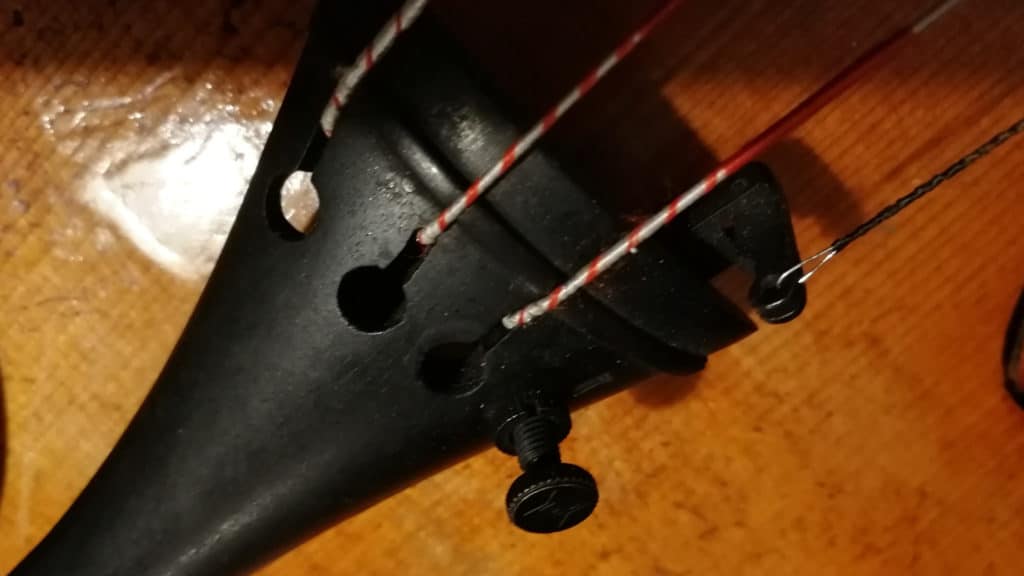
It's really hard to use a peg to tune the E string! Small adjustments are particularly difficult, because the string is so thin and wiry, and therefore more difficult to handle.
E Strings are also much more prone to snapping than other strings, because they are thinner and therefore do not handle changes in tension so well. Using a peg to tune an E string only makes this problem worse!
That is why a fine tuner is usually fitted to nearly all E strings, whereas it’s just not as necessary for the other strings.
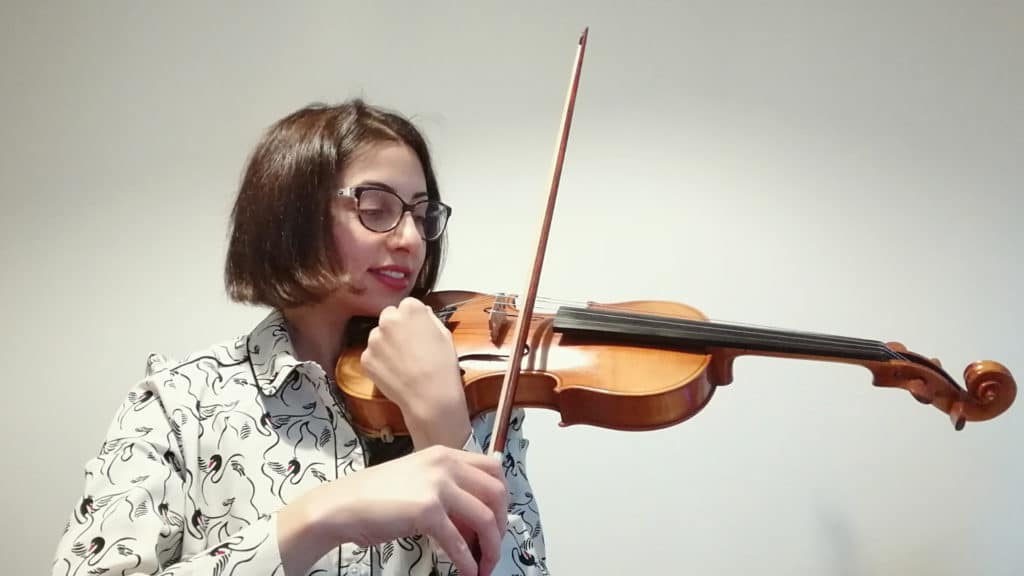
Fine tuners are good for making small changes to the pitch of the strings.
As a general rule, changes of approximately one note (i.e. a semitone , or a ‘half step’) are more easily handled with the fine tuners than with the pegs.
Anything larger than that will require so much turning, that it will take the fine tuner significantly out of line from the other fine tuners.
For this reason, it's a good idea to learn how to use the pegs so that you can handle big string adjustments, and then use the fine tuners to finish the job!
Which way do I turn the Fine Tuners?
If you're having trouble remembering which way to turn, then drill this into your head...
Turn it LEFT to make it LOOSE!
Turn it RIGHT to make it TIGHT!
Sticky/Squeaky Pegs:
If the peg is 'sticky' i.e. it's hard to turn (or squeaky... or even won't turn at all!), then you can take the peg out, and rub some peg paste onto the pin at the point where it touches the hole in the side of the pegbox.
If you don't have peg paste to hand, then you can also use dry soap, or the lead of a pencil!
Tight or Blocked Fine Tuners:
If you have been using the fine tuners a lot, they will sometimes go all the way in to the end of the screw. When this happens, you won’t be able to turn them any more, because they’re as far in as they can go.
The reason we tend to turn the fine tuners more often to the right than to the left, is because more often than not the violin strings will go flatter in pitch, because the tension in the strings will reduce.
When this happens, you need to unwind all the fine tuners to a position where you’ll be able to use them again, and make adjustments with the pegs to bring the strings back to approximately the right pitch.
Loose Fine Tuners:
If a fine tuner is loose, it needs to be turned a bit further in a clockwise direction, to go back into its screw.
However, this will probably make the string too sharp, so be prepared to make some adjustments from the pegs as well, to compensate for the change.
If that doesn't solve the problem, the screw is likely to be broken, and the fine tuner will need to be replaced.
Temperature Changes:
Extremes of temperature can affect the physical state of the violin's strings, which leads to changes in the string tension.
For this reason, you may find that your violin goes out of tune when you take it between different places where there are different extremes of temperature (such as a warm home to a warm teaching studio via a cold subway train!).
If this happens, expect to need to use the pegs!
Any Questions?
If you have any questions about tuning, just leave a comment below and our Learning Support team will answer you as soon as we can!
Next Steps For Learning:
This feature is part of our free online course called ‘Get Set Up’, which explains all the most important information about violins, bows and accessories. Click here to explore the rest of this free online course!
We've been busy over the Christmas holidays! Here’s a sneak preview of what’s about to launch at ViolinSchool...
To coincide with the start of New Year Term at our London School, we’re opening up our new and improved Digital Library to all existing members.
If you have an active subscription to ViolinSchool.com, you can already log in and download anything and everything (you may need to reset your password).
Each week we’ll be adding more learning resources, and of course we always welcome requests for new repertoire, video tutorials and exercises.
Explore the New Digital Library >>
 The Online Courses are moving back to the main ViolinSchool.com website, and we’ve been busy upgrading each course so that it fits the offline courses that we run in London.
The Online Courses are moving back to the main ViolinSchool.com website, and we’ve been busy upgrading each course so that it fits the offline courses that we run in London.
Updated versions of the free-to-access Get Set Up and Beginner Quick Start courses will be available later this month, then during February and March we’ll be releasing Course A, Course B and Course C.
These comprehensively upgraded courses will include all the exercises and pieces of music from the Beginner Violin Courses that we run in London.
For the first time, we’ll also be introducing courses for Parents & Children.
And we’re updating the all-important topics of How to Practise, How to Play in a Group, and How to Perform!
Our weekly updates start again later this week - keep an eye on your inbox for all the latest new learning resources from ViolinSchool!
Not on our mailing list yet? Leave your email address here for free learning resources each week!
Click below to play a Christmas Greeting from The Violin Orchestra!
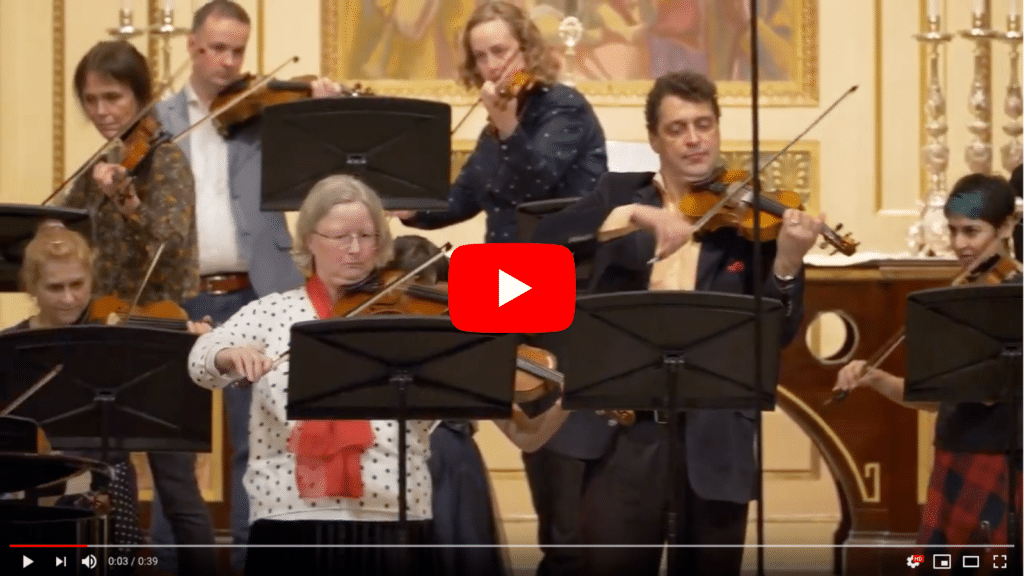
We'll be back in early January with all-new online courses, our upgraded digital library and weekly updates of everything that's new in the world of violin!
Have a wonderful holiday season and we'll see you in a couple of weeks!
And now, some CHRISTMAS CAROLS... click below to download!
Need some lyrics for people to sing as you play? Click here for the lyrics!
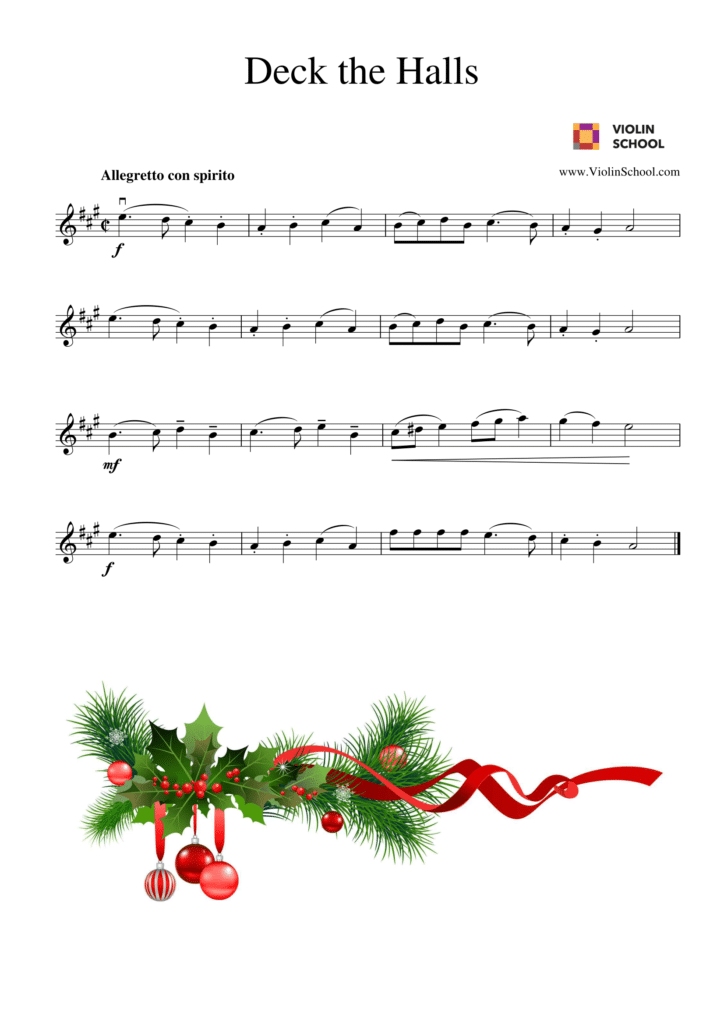
Deck the Halls
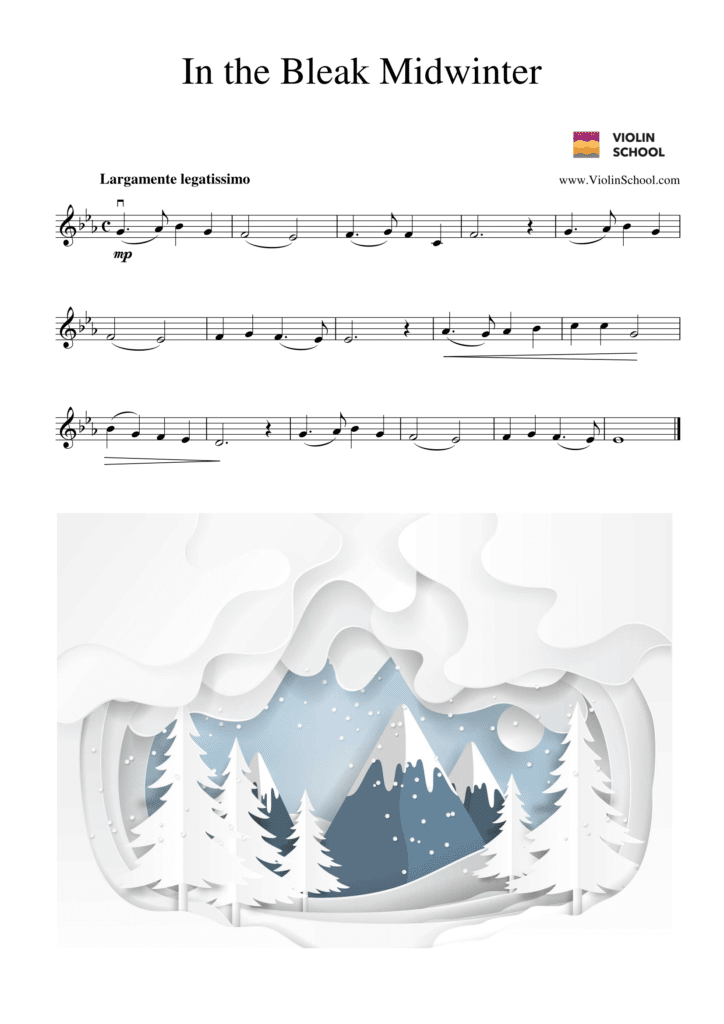
In The Bleak Midwinter
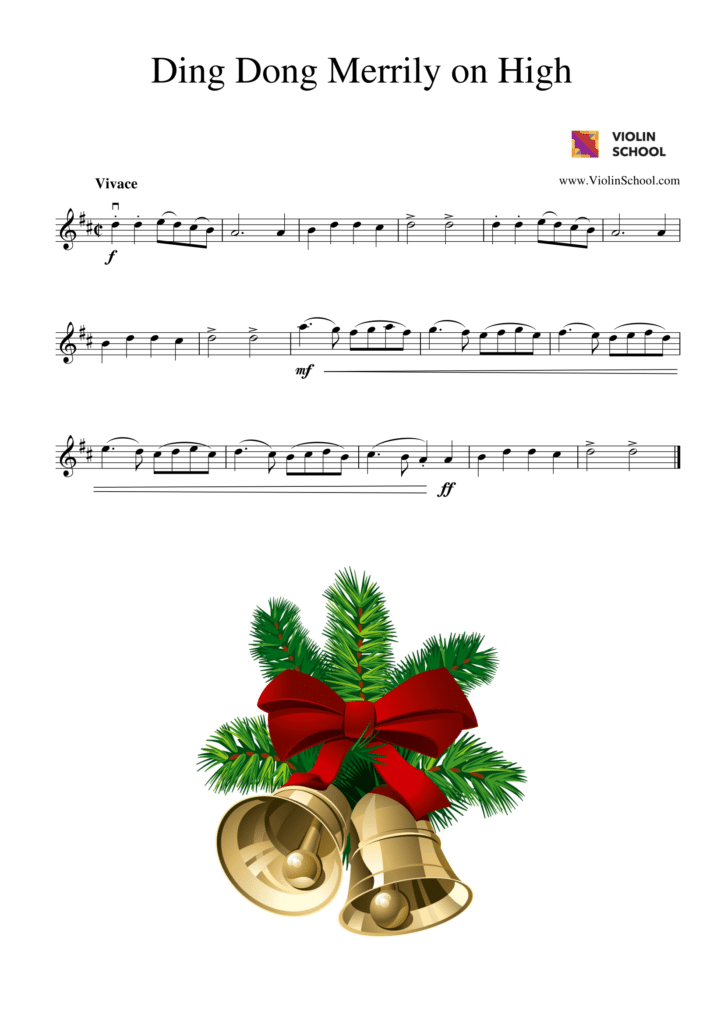
Ding Dong Merrily on High
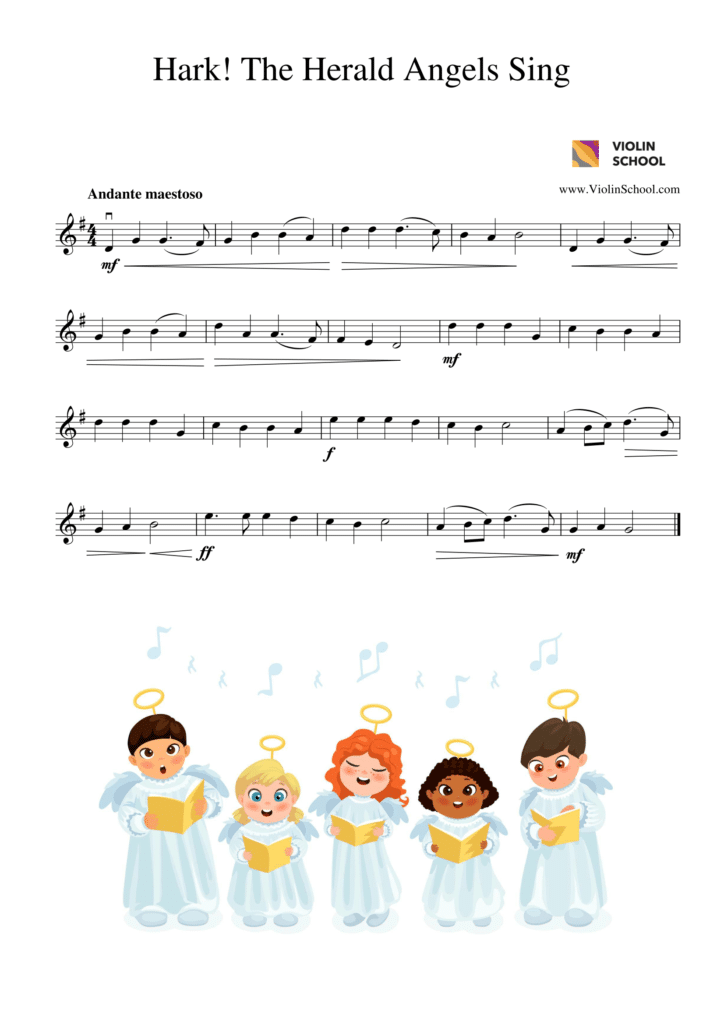
Hark! The Herald Angels Sing
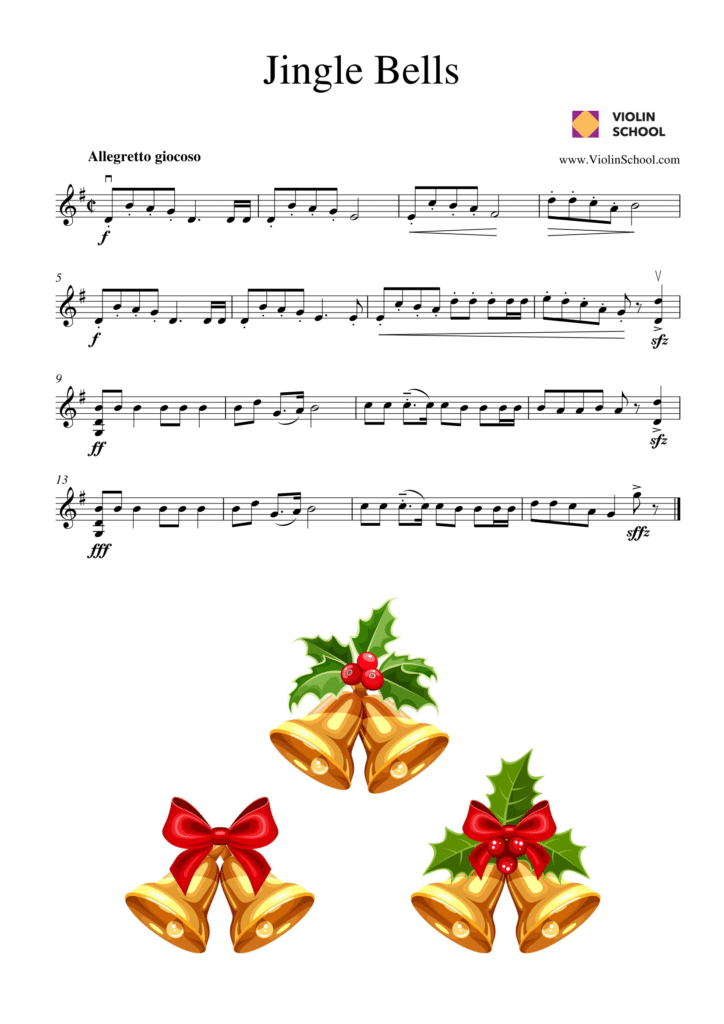
Jingle Bells
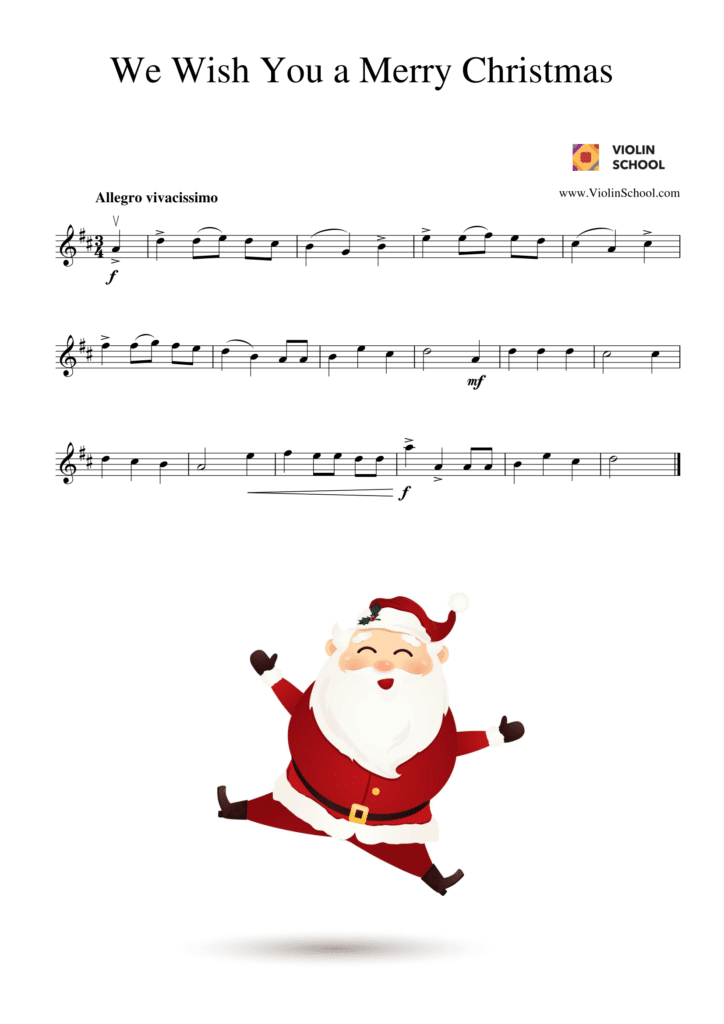
We Wish You A Merry Christmas
Our new Beginner Violin Courses at ViolinSchool London have been growing in popularity over the past year, so we've now introduced three levels - A, B and C - to help first-time adult learners to reach a good basic playing level on the violin!
Until 10pm on 9th December, learners in the UK can save £100 on all courses (£50 on Children's Course) with our 'Earlybird' booking discount for early enrolments.
Adult Learners should take a look at the Beginner Violin Courses here:
https://london.violinschool.com/beginner-violin-course/
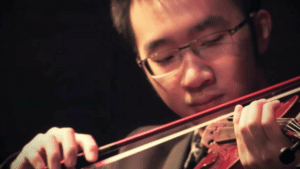
Parents, check out our new Children's Violin Course here:
https://london.violinschool.com/childrens-violin-course/
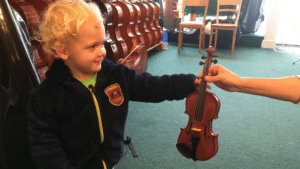
Or check out the full Tuition options at on the dedicated website for our London school.
If you're not in the UK don't worry... we'll soon be sharing all the content from these great courses on our eLearning platform.

Title: G Major: Exercises in Thirds
Description: Here are some exercises for practising the G Major scale in thirds. Make sure you practise slowly, and be very aware of the position of your bowing arm.
Level:
Topics:
[wcm_restrict]
Click here to download it!
/wcm_restrict]
[wcm_nonmember]
Join ViolinSchool today for instant access!
This download is for ViolinSchool members only! Click here to become a Member of ViolinSchool and get instant access to all library downloads!
/wcm_nonmember]
It's all very well learning the violin through lessons and your own practice sessions. But until you're out there in the real world, playing music with other people, it can all feel a bit theoretical.
Of course, it's important to learn solo pieces, and spend time on your own carefully building your technique. In fact, the intellectual challenge of tackling the many subtle layers of violin technique can be very rewarding in itself!
But when we talk about 'making music', we're really referring to the magic that happens when you play with other musicians. That's when we have to listen and interact with each other ... and that's never going to be the same every time. Playing music with other people is a truly creative endeavour.
When playing in a group, you need to develop a fairly strong instinct for what you're doing, so that you can shift your focus away from your own playing and towards other people's. That's how you keep your awareness high, so that you can always sense what's going on, and respond accordingly.
You need to rely on your training and instinct to deliver the technique you need, so that you can stay in the present moment, and focus on the people around you... and on the music that you're creating and sharing together!
At our London school we run a series of ensembles and other community music making opportunities throughout the year, including our popular Violin Orchestra, and the Saturday ViolinHubs where we build up Technical, Performance and Repertoire (group playing) skills.
If you don't have similar opportunities in your area, then it's a good idea to ask around at music schools and shops, to see if there are any local people who are interested in playing music. You'll be surprised at how many 'hidden' musicians there are... people who've played music as a child, and would love to start playing again. Could you start your own music group, meetup, or even an ensemble?
The social aspect of playing music together is incredibly important. As well as providing strong connections to your local community, playing in a group or an orchestra is really great for personal development... and it's often simply a lot of fun, especially when players become good friends!
But orchestras and ensembles are all about using what you already know to create great music. So what happens if you haven't yet learnt how to play?
Traditionally, musical instruments have been taught on a 'master and apprentice' basis, where a reputed musician will pass on their knowledge and understanding during 'one to one' lessons and personal coaching sessions.
But what we're increasingly finding at ViolinSchool is that the social aspect of being in a group can be incredibly beneficial to the effectiveness of your learning.
Whereas in a one to one lesson you only get access to the knowledge of one expert, a group tuition program (such as our Beginner Violin Courses for Adults and our Children's Violin Courses at our London School) can help give you wider context for your learning.
Firstly, you become aware of the progress of the group, and whether you're keeping up. You can see the progression that's expected during a course, and supplement your learning with class resources and a curriculum.
But most of all, you can talk and engage with your fellow learners, discuss ideas that have been covered in the class, and support each other (with perhaps a bit of friendly competition to motivate you along the way!).
As relationships develop with the people around you, you learn more about yourself by learning about each other. Each of us starts with different strengths and weaknesses, and the way that we overcome challenges and obstacles can be both informative and inspiring to other learners.
Being generous with our knowledge and wisdom not only helps other people to progress, but it helps us ourselves to grow. One of the best ways to truly know whether you understand a topic, is to explain it to someone else. By sharing and discussing ideas in a social learning context, we become better and stronger - both as a community, and as individuals.
Social learning doesn't replace one to one attention... there are times when a bit of personal tuition is exactly what's needed in order to break through a particular obstacle, or work in detail on a complex task that needs the advice of an expert, for example.
But a good selection of social learning and playing opportunities blended with online and one to one tuition can provide an excellent mix of perspectives, environments, information sources, and experiences... all of which will enrich your life as a violinist and musician!
If you're about to embark upon a Violin Course, a series of violin lessons, a new school term, or even just a new routine of regular practice, then it makes sense to get your instrument into the best possible condition before you start!
There are few things more frustrating (and demotivating!) than diving into a new period of learning with excitement and enthusiasm, only to find that you can't make progress because your tools are faulty, worn or out of date! So follow this checklist before you go to your first class or practice session!
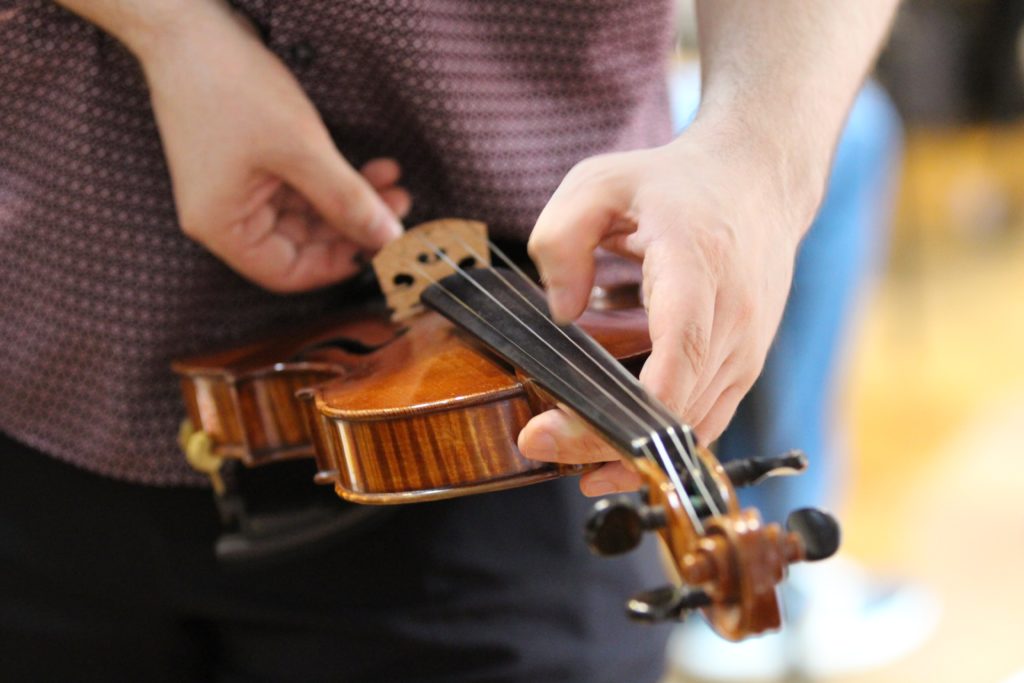
Check the Strings
Violin Strings wear out. If you've been playing a lot, you'll find that they may have become worn, dull in sound, or even started to lose their outer coating (in which case they'll need replacing immediately - before they hurt your fingers, or weaken and snap!)
Or if you've not been playing at all, and the violin has been sitting unplayed in a cupboard for a while (it happens!), then the strings may have deteriorated through lack of use. Either way, one of the smartest things you can do before starting a new course is to check (and if necessary replace) the strings.
For regular players, it makes sense to buy a new set of strings every year or two, but if you play a lot, you may want to do this more regularly. Some professional players will replace the strings before every major concert tour, but it quickly becomes an expensive habit if you do this every couple of months!
On the other hand, you don't want to leave it years between each string change. Even if you don't notice the strings wearing out because it's so gradual, you'll definitely hear the difference once a new set is on the violin... it breathes new life into an instrument!
Spare Strings
It's remarkable how many people, especially at beginner level, don't have a spare set of strings. Strings do sometimes break - this is normal! But if you're nowhere near a violin shop, or need to wait for an online order to arrive, you may find yourself unable to practise for several days...
...don't risk it! Get a spare set of strings and you'll be prepared for when string disaster strikes!
'Playing In' New Strings
If you replace your violin strings the day before your first class, then you should expect to have minor difficulties tuning the violin for at least a couple of days. This is because new strings need to be 'played in'... they need to get used to the tension that's created by winding and fixing them onto the violin.
The strings will naturally stretch during this process, which musicians sometimes refer to as 'settling' ("I just changed my strings; they need some time to settle"). Until newly attached strings are stable, you may find that they violin slips out of tune far more than usual!
The amount of time it takes for violin strings to settle does depend on the make and model of the string, and on the thickness (generally, the lower strings will take longer to settle than the higher strings, though this can vary). As a general rule, a few hours of playing over a couple of days is usually enough to 'play in' strings to the point at which they become stable.
Keep a set of old strings!
It's good practise to have used strings on hand in case you have a string break during a concert, and need an urgent replacement that's already been 'played in'. After all, if a string has already been stretched and worn, it's not going to slip out of tune as easily as a brand new string that hasn't been used.
So keep your most recent set of old strings in your violin case... just in case you have a string snap just before - or even during! - a concert or event. You'll be glad you did!
Check the Bow Hair
Another 'perishable' part of your equipment is the bow hair. Over time, the bow hair - like the strings - becomes worn and less responsive. Bow hair can also become dirty (especially near the heel, if you're in a habit of making contact between the bow hair and your right thumb.
So you should consider refreshing it on a regular basis (but be aware that, if you're using a cheap bow, it may not make economic sense... bow rehairs are usually more expensive than replacing cheap bows).
It's also common for the hairs of the bow to break from time to time (especially if you're playing a lot of ferocious, fast music... or if you're pressing too hard on the string!).
So even if your bow hair is fairly new, make sure that you've got a full complement of bow hairs on the bow, and that it's not becoming too one-sided (as hairs will tend to break on the far side of the bow - i.e. away from you - due to how we tilt the bow when playing).
If you play a lot, then you might find yourself needing to replace the bow hair more than once per year. But for many people, it's something that only needs to be done every couple of years.
Accessories
Is your rosin in good condition? Is your music stand working well? Do you have enough pencils and pencil sharpeners? Do you need to replace the soft cloth that you use for wiping down your violin after using it?
It's easy to get into bad habits and forget how important these tiny details are. Having a 'duster' or microfibre cloth (for wiping rosin off the instrument's surface when you put it way) is a good example... there are plenty of violinists who keep the same cloth for so long, and don't think of ever washing or replacing it!
Music stands, especially cheap collapsable ones, can break easily. And though it might seem like a secondary detail, a faulty music stand can be enough to significantly disrupt a violinist's practice routine! Make sure that you have all these little things taken care of, and you'll have fewer obstacles in the way of achieving your learning goals.
Here's a comprehensive list of things to check before embarking on the next stage of your learning. Can you think of anything we've forgotten? If so, let us know at [email protected]!
The Violin
The Bow
Accessories

Title: Double Stopping in Sixths - Exercises
Description: These exercises are brilliant for practising double-stopped sixths! Use them for intonation work, and to develop a really solid left hand technique!
Level: Level 5, Level 6
Topics:
[wcm_restrict]
Click here to download it!
/wcm_restrict]
[wcm_nonmember]
Join ViolinSchool today for instant access!
This download is for ViolinSchool members only! Click here to become a Member of ViolinSchool and get instant access to all library downloads!
/wcm_nonmember]

Title: Hook, Line, & Sinker
Description: Hook, Line, & Sinker is a great study to use for practising hooked bowing. We use this technique to avoid unwanted accents or using too much bow when playing uneven note values. (such as dotted rhythms) in order to avoid unwanted accents on the shorter notes and to stop us from running out of bow!
Level: Level 6, Level 7
Topics:
[wcm_restrict]
Click here to download it!
/wcm_restrict]
[wcm_nonmember]
Join ViolinSchool today for instant access!
This download is for ViolinSchool members only! Click here to become a Member of ViolinSchool and get instant access to all library downloads!
/wcm_nonmember]

Title: Intonation Exercises - 1st-7th Position
Description: For a happy marriage of aural and muscle memories, keep the first finger down and learn the distances to the other notes within the hand ‘frame'.
Level:
Topics:
[wcm_restrict]
Click here to download it!
/wcm_restrict]
[wcm_nonmember]
Join ViolinSchool today for instant access!
This download is for ViolinSchool members only! Click here to become a Member of ViolinSchool and get instant access to all library downloads!
/wcm_nonmember]
'Big Circles' are simple, straightforward exercises that you can use as a warm up at the beginning of your practice. They're also useful for improving your bow control, and your feeling for the 'balance' of the bow.
Before we get started playing Big Circles, we need to be clear about how the balance of the bow works.
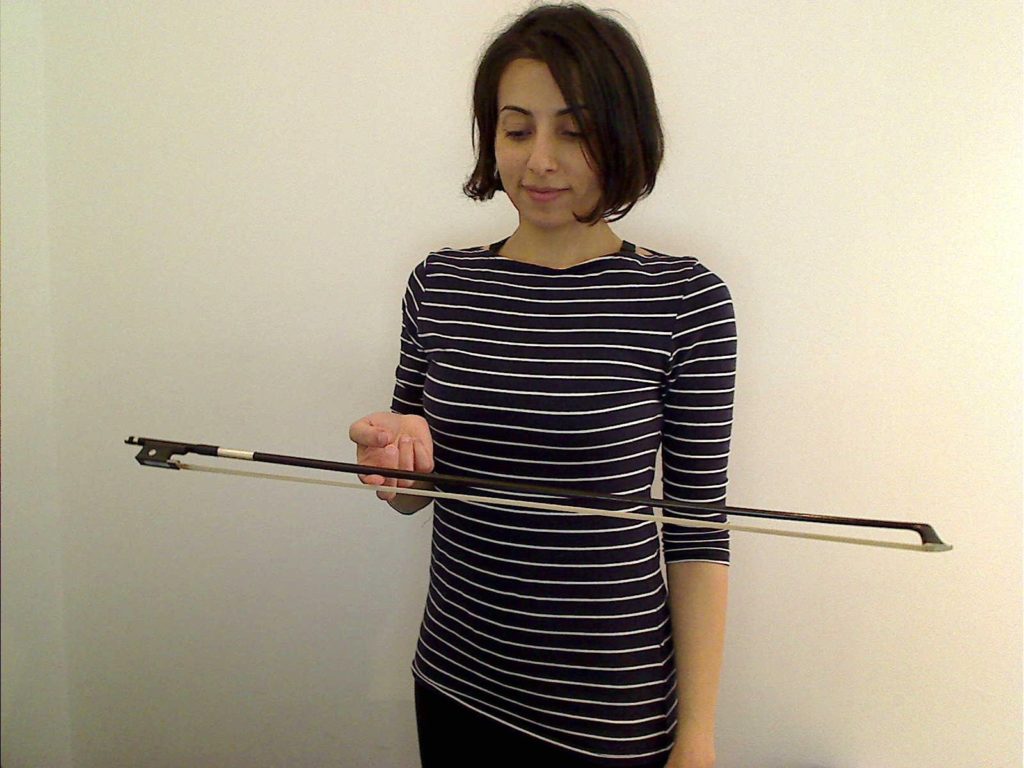
Depending on where we play in the bow, the balance of the bow changes. This is because at any given moment, there is more of the bow - and therefore more bow weight - on one side of the strings than the other.This is why we have to have a flexible bowhold that is constantly rebalancing the weight of the bow, by acting as a suspension system. If instead we have a 'fixed' bowhold that quite literally 'holds' the bow, then we can't rebalance the bow properly, and we end up with a hard, inflexible sound!
One of the areas where we need to 'balance the bow' the most, is at the very heel of the bow (the bottom end, where the bow hair connects into the 'nut' or 'frog' of the bow). When we are playing at the heel, the bow is very unbalanced, because most of the bow weight falls to the left of the strings (as you look at it whilst playing).
This is why it's hard to control our bow strokes in the lowest quarter of the bow.
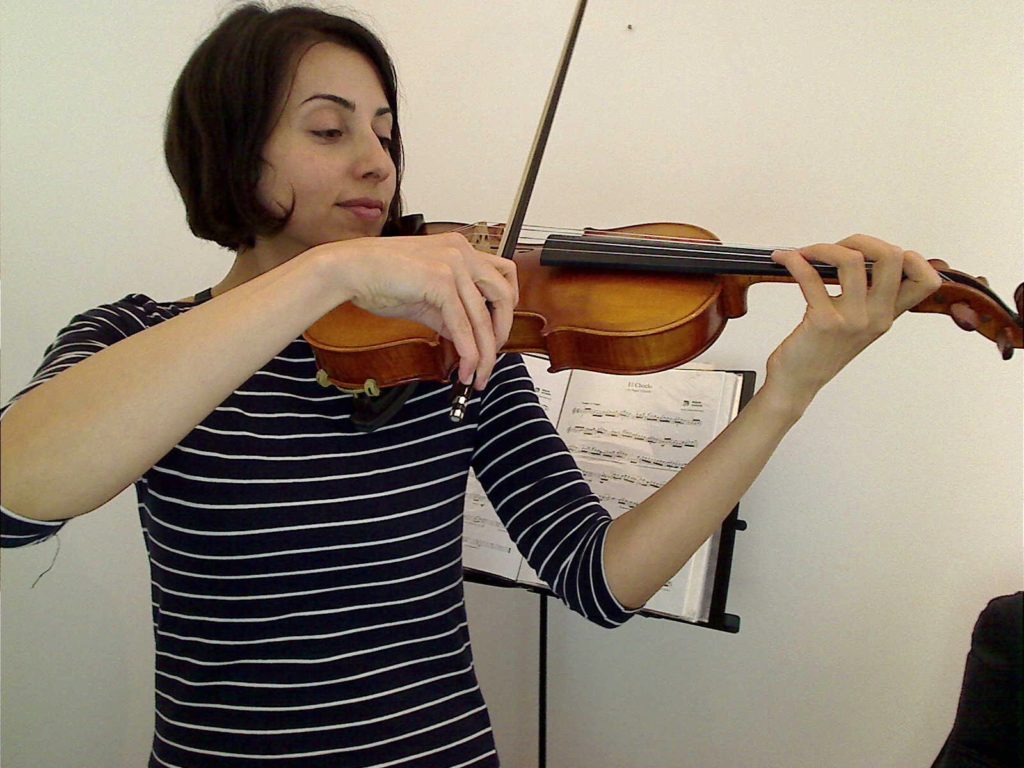
To stop the bow falling in the wrong direction, we use the little finger as a counterweight. When the little finger is sitting on top of the bow, and its knuckle is engaged as a counterweight, it stops the bow falling uncontrollably.This provides stability to the bowing movements, and allows us to bow smoothly at the heel.
Big Circles: Relying on the Little Finger
The Big Circles exercise relies on the little finger operating correctly. If the little finger isn't acting as a counterweight, then the exercise won't work!
So the first step is to check that your bow hold is correct.
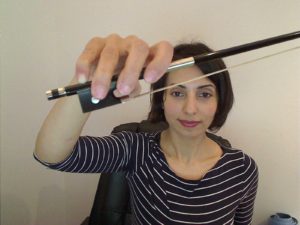
Use our Checklists to be sure that you've checked each part of your posture and your bowing arm technique, before you begin!
Raise your bowing arm into the air. Make sure that your little finger is already working as a counterweight, keeping the bow steady as you move.
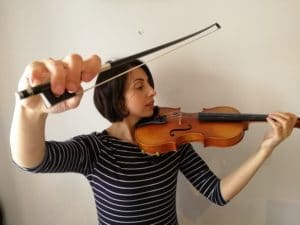
Breathe out, and relax your body as much as you can without collapsing your posture. As you breathe out, lower the bow downwards towards the string (start with the D or the A string first). Focus in on your little finger, and feel how it continues to support the weight of the bow.
Allow the bow to touch the string very gently, but stay focused on the little finger counterweight. The little finger should continue being a counterweight until the bow is firmly engaged with the string, and above the level of the balance point (half-way point in terms of weight) of the bow.
Play a down bow all the way until the tip of the bow. Feel how the bow balance changes throughout the stroke, and note how the feeling in your right hand and fingers changes throughout the stroke.At the beginning of the stroke you will be trying to counter the heaviness of the bow weight, and not let it fall too heavily into the string.During the stroke, the bow will become more balanced, and your hand/fingers will not have to 'do' so much.Towards the tip of the bow, you may need to add in more weight into the bow, to create a consistent sound all the way to the end of the stroke.
Repeat the Big Circles several times, and stay focused on:
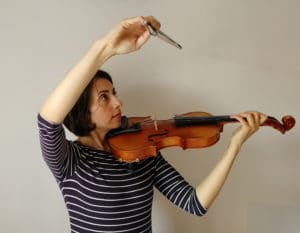
Long Slow Bows are one of the best - and most straightforward! - techniques that you can use to warm up on the violin! They're also great for improving your bow technique.
Practising Long Slow Bows involves playing lots of up and down bows on your violin. But even though the task isn't complicated, there are lots of things you need to look out for ...
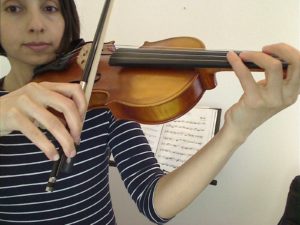
Here are some of the things you should check for when practising Long Slow Bows:
Posture - Is your body correctly positioned? Are all the elements of your body posture, your right arm and your left arm technique in the right place? (If you're not sure, use our '3 Important Checklists' to find out!)
Bow Control - Is the bow doing exactly what you want it to, and nothing else? Or does it have a life of its own? You need to make sure that the speed, weight and placement (position of the bow) are exactly how you want them to be!
Pure, Clean Sound - if you have good bow control, then you can create a beautiful, clear, vibrant and resonant sound. Listen closely to your sound production, and make sure there aren't any 'rough edges' to the sound.
Straight Bows - The bow needs to remain at right angles to the string as you play. This is what we call a 'straight' bow. If it doesn't remain straight, then the connection between the bow hair and the string will be disrupted, which will affect the sound you create.
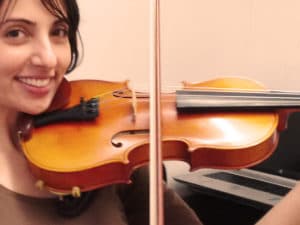
Many people like to take a few minutes to play Long Slow Bows at the beginning of a violin practice session. It's a great way to get warmed up and ready to play - and it can be a useful way of 'clearing the mind' and focusing your awareness on your sound production.
It's a particularly good exercise because it's so simple... there aren't any other complicated techniques or musical demands filling up your brain, so you're free to focus on the sound, and the precision of your core bowing technique!
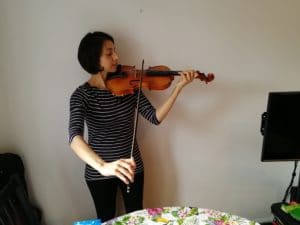
There are a few methods that you can introduce to your Long Slow Bow practice that will increase the effectiveness of what you do.
Play it SLOW! - This is sooooo important! Yes, the clue is in the name... it should be obvious! But it's easy to forget about bow speed after a few strokes, particularly if we're feeling enthusiastic and want to move quickly through our practice tasks.
But you need to stay disciplined and make sure that you take the time to play with a slow bow stroke. It's actually MORE challenging to play with a consistently beautiful sound at a slow tempo than at a fast tempo. So practising slowly is extremely helpful for the development and maintenance of your bowing technique.
Also, when you play slow, you have more TIME to consider the movements that you're making, and the sound that you're producing. This means you can listen in more detail to the resonance of the sound that you're producing, and make adjustments as you go along!
Play it IN TIME - It's one thing to get a technique working fluently, but it's another task altogether to make it work effectively in time with the music.
So once your Long Slow Bows are generating a consistently beautiful sound, you should try increasing the precision of your bow control by adding a regular beat.
A simple way to do this is to set a metronome at 60 beats per minute, and then making each Long Slow Bow last for four beats. That way you're using a quarter of the bow for each beat.
Once you've tried a few strokes like this, you'll feel how important it is to get the bow speed consistent, in order to stay correctly in time with the metronome. This will help to improve your co-ordination and the accuracy of your bowing.
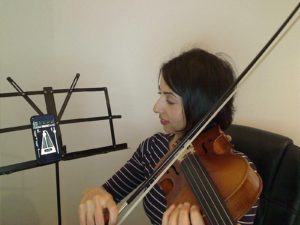
Although it's important to have a good set of practice routines, you should change around your tasks from time to time. You don't want to get 'stuck in a rut' by doing the same things over and over again!
Be creative in your technical practice, especially if you want to develop as much flexibility as possible in your bowing.
There are SO many different ways you can practise Long Slow Bows, and you should feel free to invent different approaches and think of new ways to practise the exercises. Here are a few to get you started:
How's your slurred string crossing technique? We've just added the first video tutorial to course 1D, and it's a smooooth ride for those that string-cross steadily...
Or, if you're still getting to grips with music theory, then Setareh has a 'Quick Fix' for your sixteenth notes (or as we like to call them here in Britain, semiquavers...!), over in the Beginner Quick Start course:
Enjoy!
We've just added some new video lessons for the Beginner level...
Get to know the open strings of the violin, and how it feels and sounds to play on them. Click here to download the sheet music!

Traffic Lights
Ready ... Steady ... Gooooooooooo!!! These fun rhythms will keep you busy while you wait for the green light! Click here to download the sheet music!
Plus, one of our most popular feature articles...
One of our most popular pages on ViolinSchool.com is our article Violin Notes for Beginners. If you need a basic primer on the strings of the violin, it's a great place to start! Click here to read it: Violin Notes for Beginners
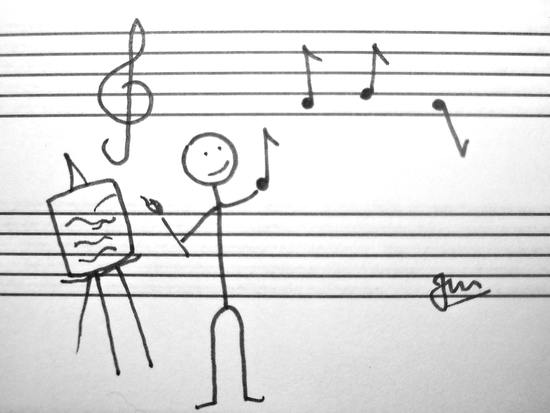
Cuckoo! An exclusive arrangement for two violins, by David Worswick, of the fabulously filigree piano piece, ͚Le Coucou͛, by French composer, Louis-Claude Daquin.
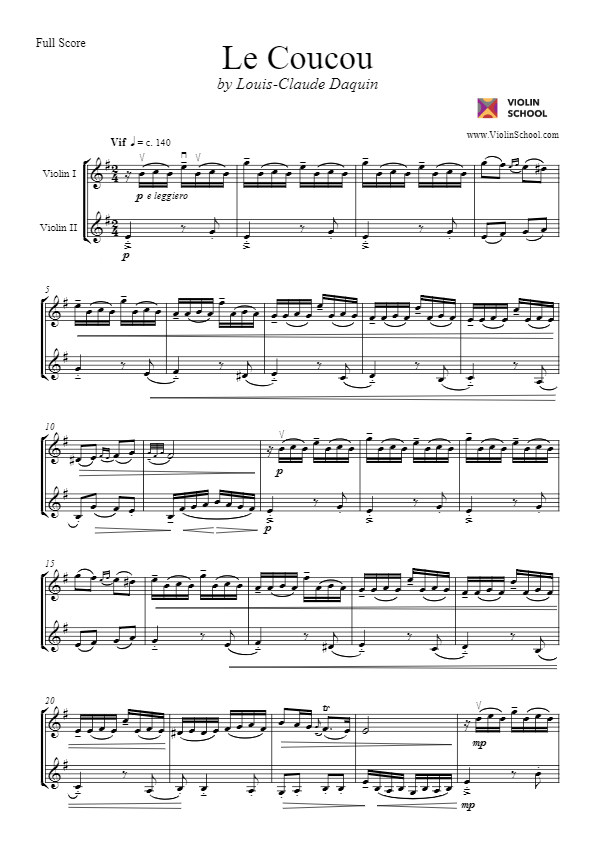
1st Position G Minor Arpeggio exercises featuring different note patterns, rhythms, bowings and articulations.
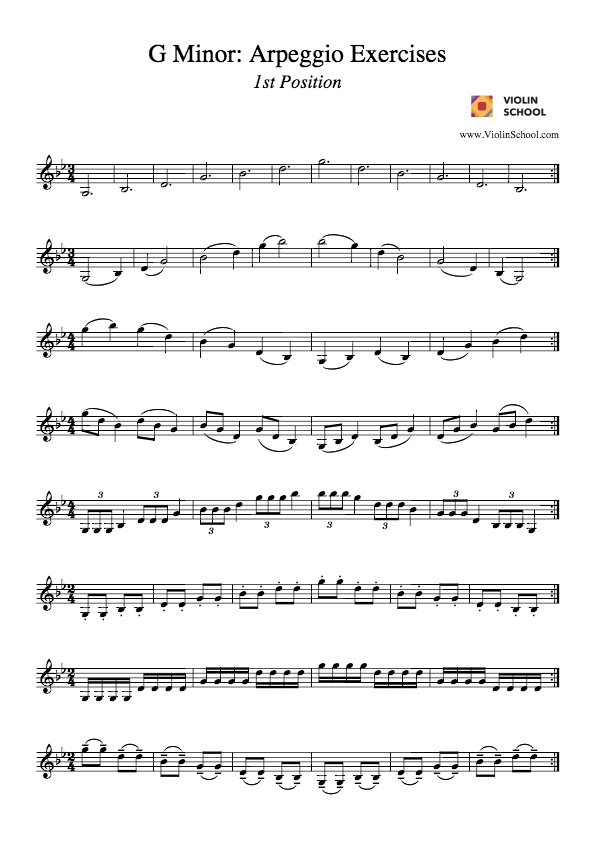
The sublime, sweeping main theme from Tchaikovsky’s much loved ballet, telling the story of Odette, a princess turned into a swan by an evil sorcerer's curse!
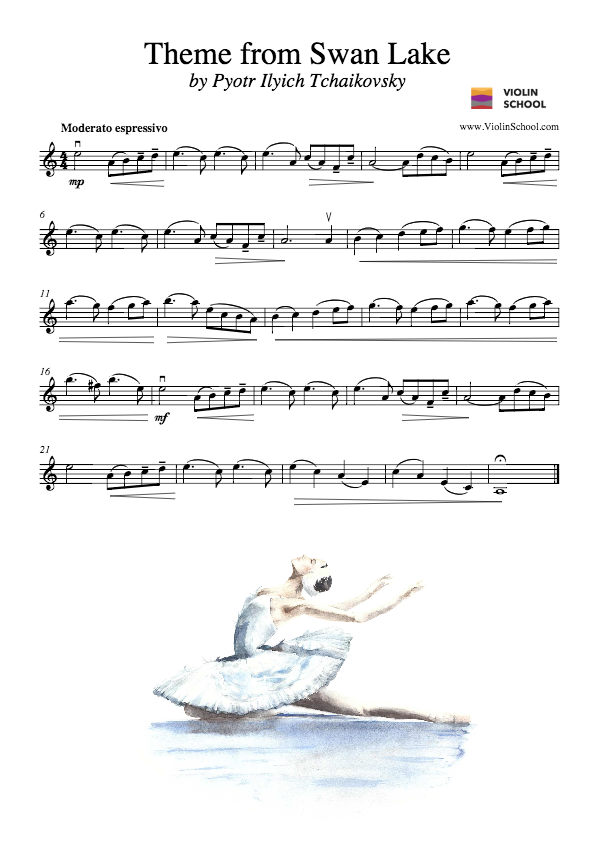
Let's practice clapping some rhythms together!
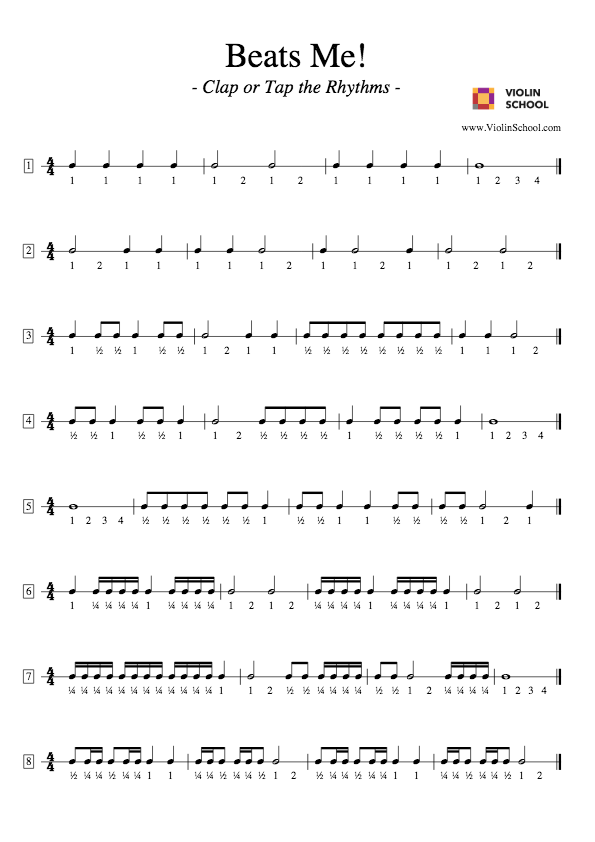
Beats Me!
What is music? It’s a surprisingly difficult question to answer! … hard to come up with a satisfactory definition. Here’s our best effort, taken from the ViolinSchool Glossary:
The vast vast majority of music will contain varieties of these three elements: Pitch, Rhythm, and Sound (timbre). And so, when you are practising the violin, you need to be super-duper-hyper aware of all three, developing and honing, developing and honing, then honing some more!
In Beats Me!, we’re going to look at the fundamental units of rhythm, the units that you’ll find in pretty much every piece you will ever play.
So, what is rhythm?! Again, let’s consult the ViolinSchool Glossary:
Sounds good. But, what is pulse? How is it different from rhythm?
Once we’ve established the pulse, felt the beat, then rhythm can take place within and around it. It’s such a natural, human thing (and a parrot thing, too, it would seem … keen “headbangers” that they are!). When we ‘sense’ the pulse, or ‘feel’ the beat, it makes us react kinaesthetically: we tap our feet, we clap our hands, we nod our heads, we dance! The pulse of music can be super super fast, or super super slow, and everything in between … we call this the ‘tempo’:
The basic units of rhythm are as follows:
American Terms --- Whole Note (4 beats); Half Note (2 beats); Quarter Note (1 beat); Eighth Note (½ a beat); & Sixteenth Note (¼ of a beat)
British Terms --- Semibreve (4 beats); Minim (2 beats); Crotchet (1 beat); Quaver (½ a beat); & Semiquaver (¼ of a beat)
Now we’re clear on the definitions, let’s try clapping or tapping the rhythms in Beats Me!
Make sure the pulse is really solid and consistent. Start with a slow tempo, and then try it at a faster tempo, and then at an even faster tempo, etc., etc. You can also ‘speak’ the rhythms while you clap/tap, saying out loud “1-2-3-4” … “1-2” … “1” … “half” … “quarter”.
A great way to strengthen your sense of pulse (and to check you are getting all the rhythms right!) is to use a metronome … Glossary-time! …
Have fun!
Time to cast some spells! Your bow becomes a magic wand to conjure up some wondrous sounds in this bedazzling little open string piece. Abracadabra!!
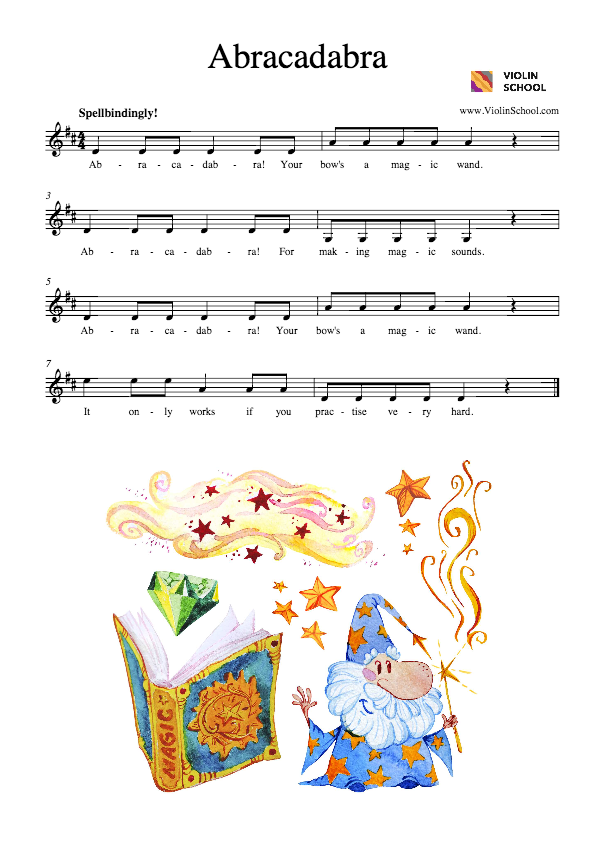
Arpeggio-based note patterns, rhythms, bowings, techniques, and articulation exercises in 1st position G major.
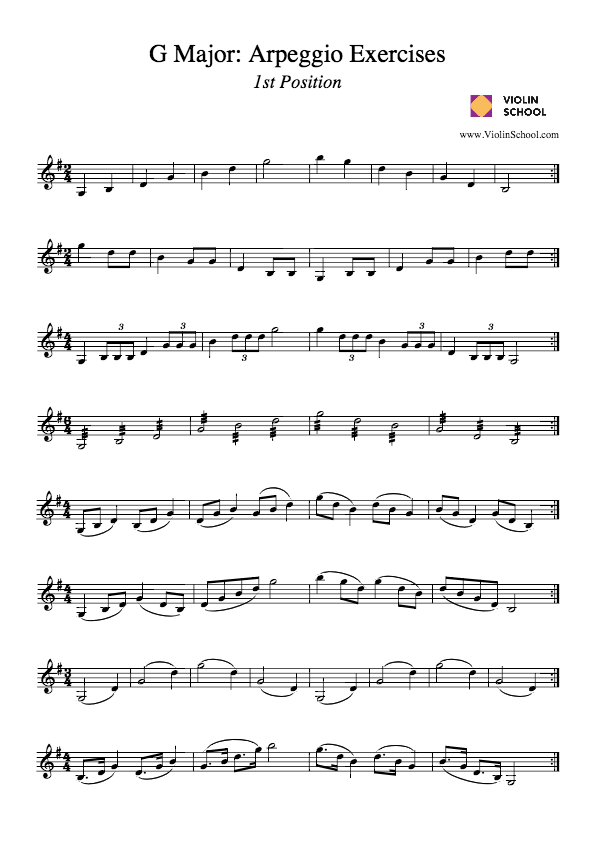
From a galaxy far, far away … comes this fantastic piece for practising landing the 4th finger of the left hand with pinpoint accuracy. Go 4th and conquer!
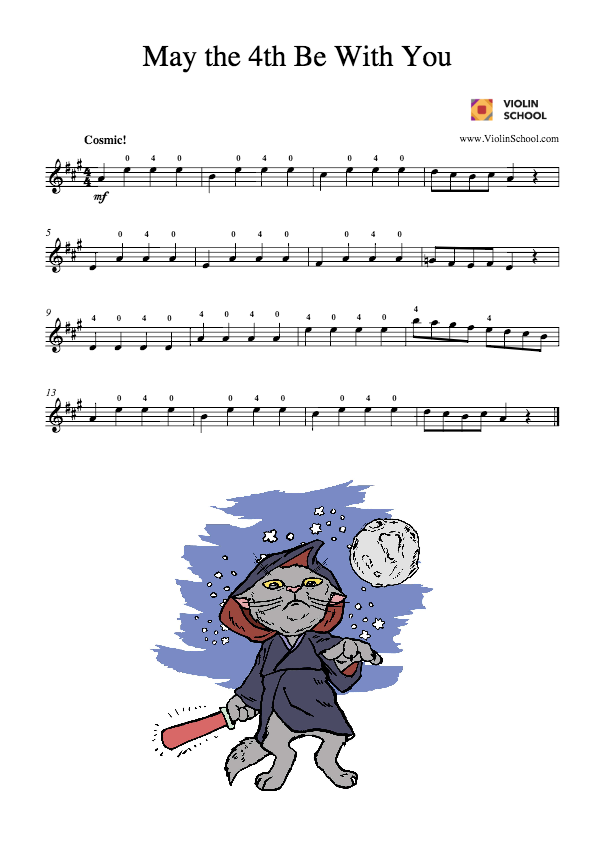
Meet George, a giant tortoise who really really loves ice cream! Find out what his favourite flavours are in this fun little piece for open strings!
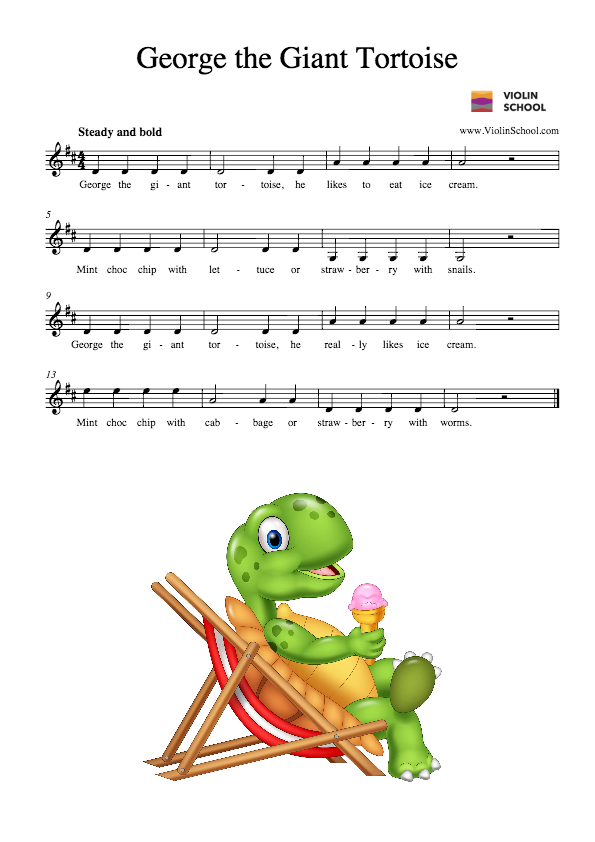
These four pieces of wood, usually carved from ebony, are used to hold the strings in the pegbox of the violin. They're shaped so that they're easy (ish!) to turn.
We use the pegs to tune the violin by turning them to tighten the string – which raises the pitch - or to loosen the string – which lowers the pitch.
Turning the peg even just a small amount will make quite a bit of change to the pitch of the string! So we need to be careful not to turn the pegs too far above the desired pitches of G, D, A, & E!
Otherwise, there'll be too much tension in the string, and it will snap!
A delightful, but fiendishly tricky, piece with lots of double stops! Keep your cards close to your chest, or in this case, your fingers close to the fingerboard!
